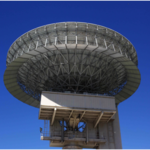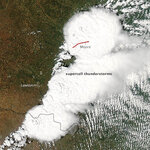Aerospace

NASA's Curiosity rover on Mars, which first landed inside the Gale Crater on Aug. 6th, 2012, may provide clues as to how the red planet lost its original atmosphere, which scientists believe was much thicker than the one left today.
Curiosity's Sample Analysis at Mars (SAM) suite of instruments measured the abundances of different gases and isotopes in samples of Martian air, according to NASA. Isotopes are variations of the same chemical element that contain different numbers of neutrons, such as the most common carbon isotope, carbon-12, and a heavier stable isotope, carbon-13,…

Tomorrow, we are being photographed from space.
No, it is not another NSA spying operation, it is NASA's Cassini and MESSENGER spacecraft, taking pictures of Earth from Saturn and Mercury.
The image taken from the Saturn system by Cassini will occur between 2:27 and 2:42 PDT (that's 5:27 and 5:42 p.m. EDT and 21:27 and 21:42 UTC) tomorrow, July 19th. Since Cassini is 898 million miles away from us, nearly 10 times the distance from the sun to Earth, it may not see you specifically but NASA is encouraging the public to get participatory and wave at Saturn at the time of the portrait and then…

We all think about space exploration, but we also need to think about dodging 50 years of debris from space exploration - aluminum, steel, nylon, even liquid sodium from Russian satellites. Sierra Club hasn't started fundraising over this issue yet but they might after reading this article.
According to NASA, there are more than 21,000 pieces of 'space junk' roughly the size of a baseball in orbit, and about 500,000 pieces that are golf ball-sized. Sure, space is big, but when a piece of space junk strikes a spacecraft, the collision occurs at a velocity of 5 to 15 kilometers per second,…

If you want to make sure your extra-terrestrial efforts can survive a nuclear attack, working inside the Jamesburg Earth Station on, fittingly, ComSat Road, just outside Carmel, California, is a fine choice. A short drive to Pebble Beach and Spyglass golf courses means it is not a bad way to spend your weekends either.
If you enjoyed seeing Neil Armstrong walking on the Moon, Jamesburg is one of the dishes you can thank. But the 10-story high antenna went out of service in 2002. The land was sold to a gentleman who wanted a vacation home - the coolest Cold War vacation home ever, if you ask…

NASA's Tropical Rainfall Measuring Mission (TRMM satellite) flew directly above tropical storm Andrea on Thursday, June 6, 2013 at 0508 UTC (1:08 a.m. EDT). This orbit showed that Andrea had a large area of moderate to heavy rainfall in the northeast quadrant of the storm and precipitation was spreading over the state of Florida.
At NASA's Goddard Space Flight Center in Greenbelt, Maryland, Hal Pierce of the TRMM Science Team used TRMM data create a 3-D view of Tropical Storm Andrea. The 3-D view from the west was derived from TRMM Precipitation Radar (PR) data captured when Andrea was…

Yesterday, a monster tornado almost 2-miles wide tore through Moore, Oklahoma, a suburb of Oklahoma City, wiping out entire blocks and killing 24 people.
The National Weather Service upgraded its calculation of the storm's strength today, declaring it was a rare EF5, the most powerful ranking on the Enhanced Fujita Scale, and had winds exceeding 200 miles per hour and left a trail of destruction measuring about 17 miles long. Debris from the tornado fell as far as 100 miles away, reaching the city of Tulsa.
Starting tomorrow, BusinessWeek, Mother Jones and others will find a way to…

The Karoo Array Telescope (KAT-7) in South Africa, the pathfinder radio telescope for the $3 billion global Square Kilometre Array (SKA) project, has released its first results.
KAT-7 is the world's first radio telescope array consisting of composite antenna structures. It is the test array for MeerKAT, a much larger radio array, which is itself in turn a precursor for the dish-based component of the SKA. These results are part of the development for the ThunderKAT project on MeerKAT, which will search for new types of radio systems that change rapidly with time.
Using the…

Imagine being the project scientist for a NASA experiment and getting an email telling you that a 3,100 lb. defunct spy satellite dating back to the Cold War might crash into your baby?
That's what happened to Julie McEnery of NASA's Fermi Gamma-ray Space Telescope, which maps the highest-energy light in the universe, a year ago. When she checked her email on March 29th, 2012, she had an automatically generated report from NASA's Robotic Conjunction Assessment Risk Analysis (CARA) saying that in about a week Fermi might be hit by Cosmos 1805.
Ideally, they were going…

A coronal mass ejection (CME) is when our sun sends billions of tons of solar particles into space. A CME can affect electronic systems in satellites and NASA recently saw three.
First CME: April 20, 2013, at 2:54 a.m. EDT, a CME left the sun at 500 miles per second (1). It may pass by NASA's MESSENGER (MErcury Surface, Space ENvironment, GEochemistry, and Ranging), which investigates the planet Mercury, and STEREO-A (Solar TErrestrial RElations Observatory) satellites but no particle radiation is associated with this event, which is what would normally concern operators of…

X-ray astronomy is only 50 years old but nothing shows the progress of the technology like a new view of a supernova scientists watched over a thousand years ago.
SN 1006 got its name because it first appeared visible to us on May 1, 1006 A.D. in the constellation Lupus (the Wolf), which is south of Scorpio.Though about 7,000 light years away from Earth, it was far brighter than Venus and visible during the daytime for weeks, so astronomers from Asia, Europe and the Arab world all documented this spectacular sight. Astronomers now believe it was a merging of two white dwarf stars…